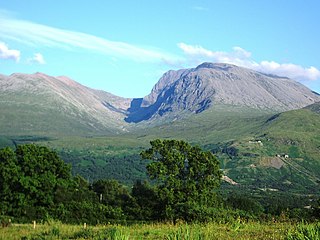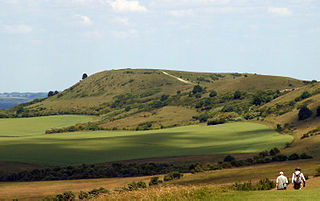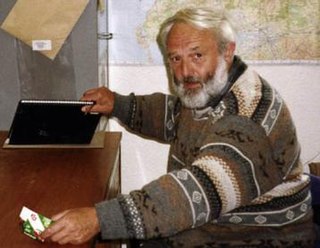
Ben Nevis is the highest mountain in Scotland, the United Kingdom and the British Isles. The summit is 4,411 feet (1,345 m) above sea level and is the highest land in any direction for 459 miles. Ben Nevis stands at the western end of the Grampian Mountains in the Highland region of Lochaber, close to the town of Fort William.

The Cairngorms are a mountain range in the eastern Highlands of Scotland closely associated with the mountain Cairn Gorm. The Cairngorms became part of Scotland's second national park on 1 September 2003. Although the Cairngorms give their name to, and are at the heart of, the Cairngorms National Park, they only form one part of the national park, alongside other hill ranges such as the Angus Glens and the Monadhliath, and lower areas like Strathspey.

A mountain hut is a building located high in the mountains, generally accessible only by foot, intended to provide food and shelter to mountaineers, climbers and hikers. Mountain huts are usually operated by an Alpine Club or some organization dedicated to hiking or mountain recreation. They are known by many names, including alpine hut, mountain shelter, mountain refuge, mountain lodge, and mountain hostel. It may also be called a refuge hut, although these occur in lowland areas too.

A bothy is a basic shelter, usually left unlocked and available for anyone to use free of charge. It was also a term for basic accommodation, usually for gardeners or other workers on an estate. Bothies are found in remote mountainous areas of Scotland, Northern England, Ulster and Wales. They are particularly common in the Scottish Highlands, but related buildings can be found around the world. A bothy was also a semi-legal drinking den in the Isle of Lewis. These, such as Bothan Eòrapaidh, were used until recent years as gathering points for local men and were often situated in an old hut or caravan.
Trees for Life is a registered charity working to rewild the Scottish Highlands.

The Scottish Charity Regulator (OSCR) is a non-ministerial department of the Scottish Government with responsibility for the regulation of charities in Scotland.

The Bishops' Conference of Scotland (BCOS), under the trust of the Catholic National Endowment Trust, and based in Airdrie, North Lanarkshire, is an episcopal conference for archbishops and bishops of the Roman Catholic Church in Scotland. The conference is primarily made up of the presiding bishops of Scotland's eight dioceses as well as bishops who have retired.

A wilderness hut, bothy, backcountry hut, or backcountry shelter is a free, primitive mountain hut for temporary accommodation, usually located in wilderness areas, national parks and along backpacking and hiking routes. They are found in many parts of the world, such as Finland, Sweden, Norway, northern Russia, the Alps, the Pyrenees, Scotland, Australia, New Zealand, Canada, and the United States. Huts are basic and unmanned, without running water.

Corrour Bothy is a simple stone building on Mar Lodge Estate, Aberdeenshire, Scotland.
The Cairngorm Club is a mountaineering club, based in Aberdeen, Scotland formed in June 1887.

Walking is one of the most popular outdoor recreational activities in the United Kingdom, and within England and Wales there is a comprehensive network of rights of way that permits access to the countryside. Furthermore, access to much uncultivated and unenclosed land has opened up since the enactment of the Countryside and Rights of Way Act 2000. In Scotland the ancient tradition of universal access to land was formally codified under the Land Reform (Scotland) Act 2003. In Northern Ireland, however, there are few rights of way, or other access to land.
The Permaculture Association is a registered charity that promotes the theory and practice of permaculture in Britain and worldwide.

Shiel Bridge is a village on the south east shore of Loch Duich at the foot of Glen Shiel, in the Lochalsh area of the Scottish Highlands. It is in the council area of Highland.
Glasgow Perthshire Charitable Society is a charity registered in Scotland.

Irvine Butterfield (1936–2009) was an environmentalist, hillwalker and author of several books about mountains and the outdoor environment who took a significant role in the running of organisations with such interests in Scotland. He was a good organiser and volunteered large amounts of his time to causes he believed in.

The Bridgend Farmhouse Community Project in Edinburgh, Scotland is a community-owned and community-run charitable organisation. The project restored an 18th-century farmhouse to provide a community meeting place, café, garden and workshops. The project runs classes, workshops and training courses in a variety of crafts and skills aimed at all age groups. It also provides facilities for performances, gatherings, talks, entertainment and small conferences. Given charitable status under the title Bridgend Inspiring Growth (BIG), the project was one of the first in Scotland to achieve community ownership in an urban setting. In 2018 it became the first organisation in Scotland to transfer from a Scottish Charitable Incorporated Organisation (SCIO) to a Community Benefit Society with charitable status.
The North Lanarkshire Chiefs are a Scottish basketball club, based in the town of Cumbernauld, Scotland.

Aonach Beag is a 1,116-metre (3,661 ft) mountain in the Highlands of Scotland in the remote area between Loch Ericht and Loch Laggan located about 4 kilometres (2.5 mi) northwest of Ben Alder. Its prominence is 99 metres (325 ft) with its parent peak, Geal-Charn, about 1 kilometre (0.62 mi) to the east. In Gaelic, Aonach Beag means "little ridge" despite it being a Munro. It should not be confused with the better-known Munro near Ben Nevis, also called Aonach Beag, about 30 kilometres (19 mi) to the west.

Gleann Dubh Lighe is a glen (valley) in Lochaber, Highland, Scotland, located at the foot of Streap in the Northwest Highlands mountain range. The Dubh Lighe river flows through the length of the valley. A frequented spot for hiking, the valley is known for the eponymous bothy located in the valley which is maintained by the Mountain Bothies Association (MBA). It accidentally burned down in late 2011, but was rebuilt in June 2013 by volunteers of the MBA.











